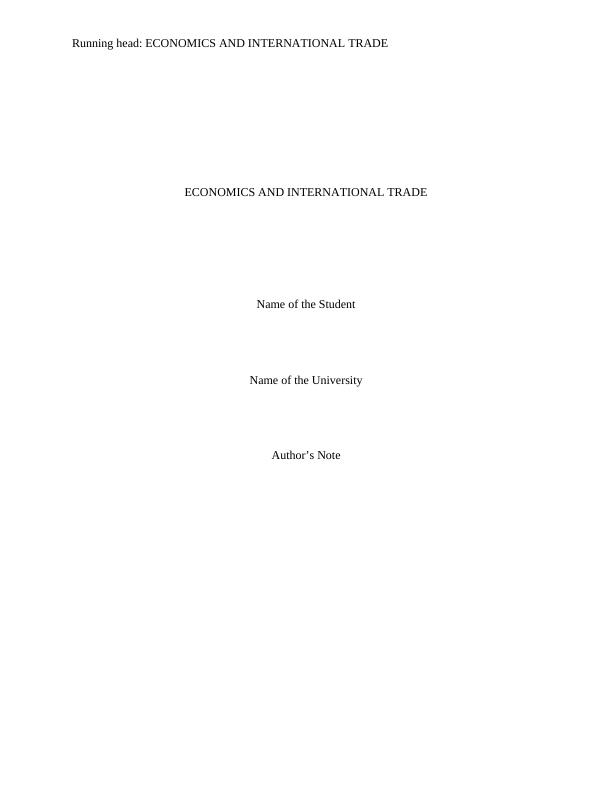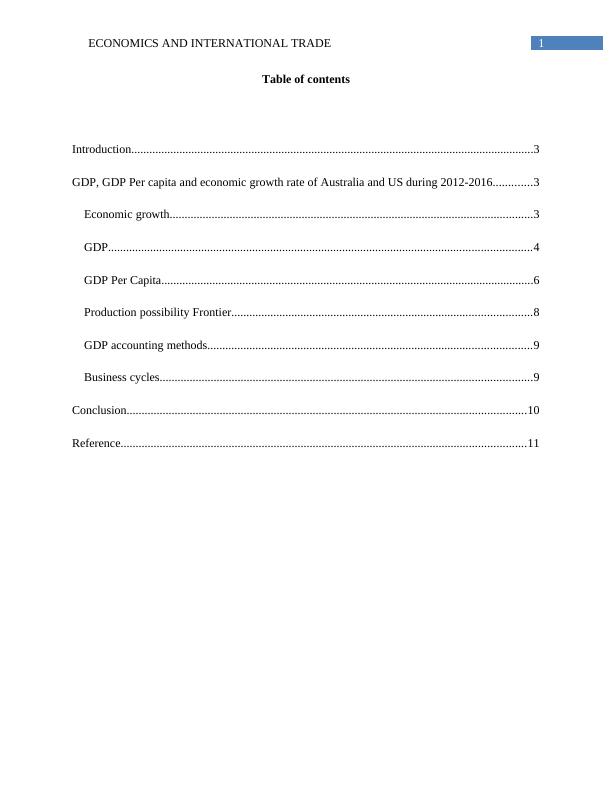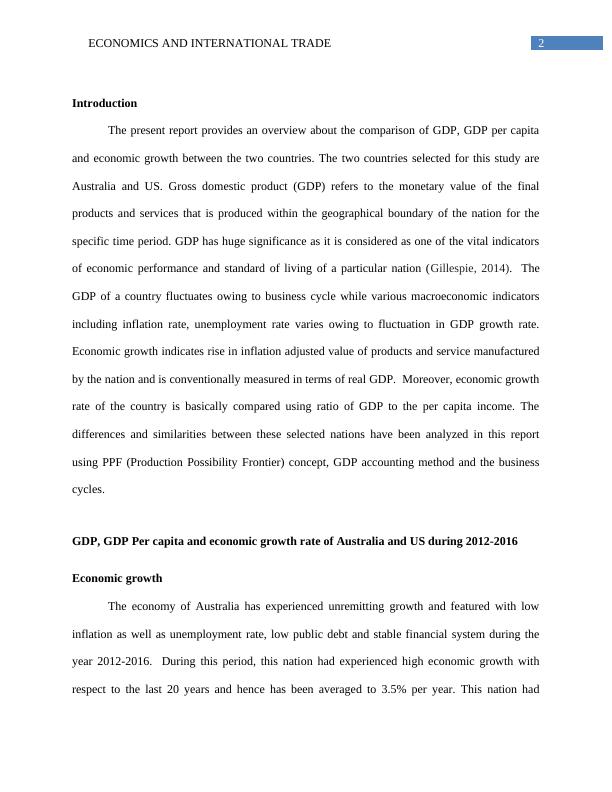International Trade Economics Assignment
Added on 2020-05-16
12 Pages2140 Words249 Views
Running head: ECONOMICS AND INTERNATIONAL TRADEECONOMICS AND INTERNATIONAL TRADEName of the StudentName of the UniversityAuthor’s Note

1ECONOMICS AND INTERNATIONAL TRADETable of contentsIntroduction......................................................................................................................................3GDP, GDP Per capita and economic growth rate of Australia and US during 2012-2016.............3Economic growth.........................................................................................................................3GDP.............................................................................................................................................4GDP Per Capita............................................................................................................................6Production possibility Frontier....................................................................................................8GDP accounting methods............................................................................................................9Business cycles............................................................................................................................9Conclusion.....................................................................................................................................10Reference.......................................................................................................................................11

2ECONOMICS AND INTERNATIONAL TRADEIntroductionThe present report provides an overview about the comparison of GDP, GDP per capitaand economic growth between the two countries. The two countries selected for this study areAustralia and US. Gross domestic product (GDP) refers to the monetary value of the finalproducts and services that is produced within the geographical boundary of the nation for thespecific time period. GDP has huge significance as it is considered as one of the vital indicatorsof economic performance and standard of living of a particular nation (Gillespie, 2014). TheGDP of a country fluctuates owing to business cycle while various macroeconomic indicatorsincluding inflation rate, unemployment rate varies owing to fluctuation in GDP growth rate.Economic growth indicates rise in inflation adjusted value of products and service manufacturedby the nation and is conventionally measured in terms of real GDP. Moreover, economic growthrate of the country is basically compared using ratio of GDP to the per capita income. Thedifferences and similarities between these selected nations have been analyzed in this reportusing PPF (Production Possibility Frontier) concept, GDP accounting method and the businesscycles.GDP, GDP Per capita and economic growth rate of Australia and US during 2012-2016Economic growthThe economy of Australia has experienced unremitting growth and featured with lowinflation as well as unemployment rate, low public debt and stable financial system during theyear 2012-2016. During this period, this nation had experienced high economic growth withrespect to the last 20 years and hence has been averaged to 3.5% per year. This nation had

3ECONOMICS AND INTERNATIONAL TRADEremained unaffected by GFC (global financial crisis) since the banking system was strong andthe inflation rate was under control. The economic growth of this nation during this period hasbeen mainly due to rise in terms of trade (TOT), diverse natural resources attracting increasedlevels of FDI (foreign direct investment) and minimal restrictions on the imports of products andservices. In addition, this procedure of opening up also increased total productivity, which in turnstimulated this nation’s economic growth (Lewis, 2013). However, this made the nation highlyflexible and dynamic. During this period 2012-2016, the economic growth of US measured interms of real GDP grew by near about 2% -3%. In the year 2012, this nation had created morethan 2.17 million jobs, the inflation rate had also remained low at 1.9% and even the value ofdollar had also remained low (Summers, 2014). In fact, the Federal Reserve had also kept theinterest rate low, which in turn increased the flexibility of the US firms. However, all theseindicators reflect that the economic growth of US had increased during this period.GDPThe GDP of US refers to the products and services manufactured within the boundarydespite whether the organization is international or the individual offering the service is theircitizen (Jorgenson, Gollop & Fraumeni, 2016). The GDP of US during the period 2012-2016 hasreflected continuous increase thereby reaching the highest in 2016 at $18624.48 USD billion.Although the GDP of this nation lowered during the period 2008-2009 owing to financial crisis,it recovered during the expansion phase if business cycle. In the year 2016, this economy hadbeen recorded as the biggest trading country and the second largest producer in the globe. On thecontrary, though Australia has been recorded for the uninterrupted GDP growth rate in thelongest run around the globe, the GDP of this country reflected slight fluctuation from the year2012 to 2016, reaching all time high in the year 2016 at $1567.18 USD billion. Moreover, this

End of preview
Want to access all the pages? Upload your documents or become a member.
Related Documents
HC1072 Economics and International Trade | Reportlg...
|16
|2454
|78
Economic Growth and GDP of Australia over the Last Five Yearslg...
|16
|3446
|258
Economic Performance of Australialg...
|15
|3138
|420
Australian Economy: Analysis of Key Economic Indicators and Future Possibilitieslg...
|11
|2024
|218
The Economic Growth of Australialg...
|20
|3835
|46
Economic Analysis of Singapore: Production Output, Unemployment, and Inflationlg...
|11
|2835
|122
